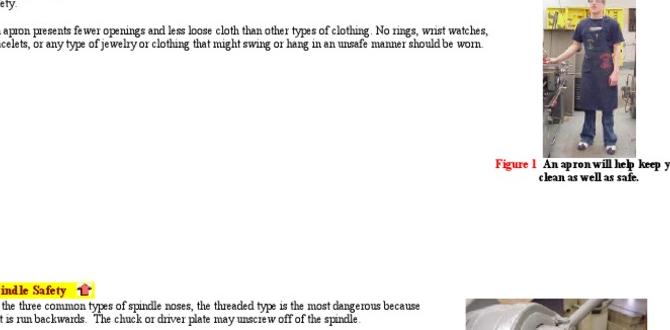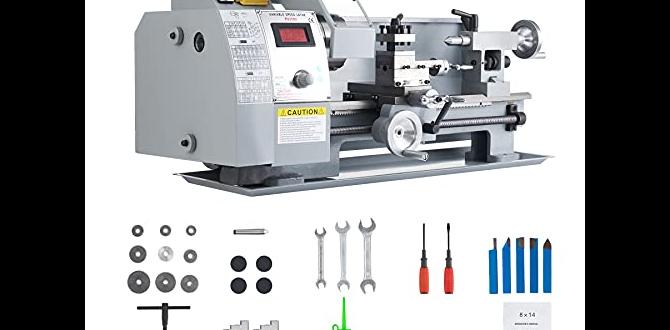For cast iron with a 1/8 inch ball nose end mill, targeting specific feeds and speeds ensures smooth cuts, tool longevity, and excellent surface finish. Finding the right balance is key for successful machining.
Working with metal, especially cast iron, can feel like stepping into a different world. Sometimes, getting the right settings for your tools isn’t as straightforward as you’d hope. You might be trying to get that perfect finish or just make sure your tools last as long as possible. It’s common to feel a bit stuck when figuring out the best way to approach a specific material and tool combination. Don’t worry! We’re going to walk through the details of using a 1/8 inch ball nose end mill on cast iron. We’ll break down the “why” behind the settings, making it easy to understand so you can get back to confidently creating. Let’s dive into the specifics to get your machining running smoothly.
Understanding Your 1/8 Inch Ball Nose End Mill for Cast Iron
When you’re facing a project involving cast iron and a precise tool like a 1/8 inch ball nose end mill, it’s essential to know what you’re working with. This isn’t a one-size-fits-all situation, and getting the settings right makes a huge difference. It’s about more than just picking numbers; it’s about understanding how the tool interacts with the material.
What is a Ball Nose End Mill?
A ball nose end mill has a cutting end shaped like a hemisphere, or half a ball. This unique shape is fantastic for creating curved surfaces, 3D contours, and fillets. Unlike flat-end mills, the radius at the tip allows it to cut in any direction without digging in, making it ideal for complex molds, dies, and intricate designs.
Why Cast Iron Requires Specific Attention
Cast iron is a bit of a special case in machining. It’s strong and durable but can also be brittle. It contains a high percentage of carbon, which can cause it to machine differently than steels or aluminum.
Brittleness: Cast iron can chip or crack if subjected to excessive force or vibration. This means your cutting speed and depth of cut need to be managed carefully.
Abrasiveness: The graphite flakes within cast iron can be abrasive to cutting tools. This means tool wear can be a concern, and choosing the right tool material and coatings is important.
Thermal Properties: Cast iron doesn’t conduct heat as well as some other metals. This means heat generated during cutting can build up, potentially affecting tool life and surface finish.
Using a 1/8 inch ball nose end mill on cast iron means you’re often working on detailed areas. The small diameter of the tool can be an advantage for intricate work, but it also means you need to be extra precise with your parameters to avoid breaking the delicate tool.
Navigating Feeds and Speeds for Cast Iron
Feeds and speeds are the heart of any machining operation. Get them wrong, and you risk damaging your tool, your workpiece, or even your machine. Get them right, and you’ll achieve beautiful results with ease. For a 1/8 inch ball nose end mill in cast iron, it’s all about balance.
What Exactly Are Feeds and Speeds?
Let’s quickly define these terms so we’re all on the same page:
Spindle Speed (RPM): This is how fast the cutting tool rotates. It’s measured in revolutions per minute (RPM). Higher RPMs generally mean faster cutting, but too high can generate excessive heat and rapid tool wear.
Feed Rate (IPM or mm/min): This is the speed at which the cutting tool moves into the material. It’s usually measured in inches per minute (IPM) or millimeters per minute (mm/min). A faster feed rate can remove material more quickly, but too fast can lead to chatter, poor surface finish, or tool breakage.
The Relationship Between Tool Diameter and Cutting Parameters
The tiny 1/8 inch diameter of our ball nose end mill is a crucial factor. Smaller tools have less mass and rigidity, making them more susceptible to breakage. This means we often need to adjust our feeds and speeds compared to larger end mills of the same type. Specifically, for smaller tools:
Lower Depth of Cut: You’ll typically take shallower cuts to reduce the stress on the tool.
Slower Feed Rate (often): While it might seem counterintuitive, you might need a slower feed rate per tooth to manage chip load appropriately and prevent overloading the small cutting edges.
Speed Adjustments: Spindle speed needs careful consideration – sometimes slightly higher is okay if chip load is managed, other times moderate speeds are better.
Calculating or Finding Recommended Feeds and Speeds
There’s no single magic number, but we can get very close using a few methods. Tool manufacturers are your best friends here.
1. Manufacturer Data: Always check the documentation that came with your specific end mill. They often provide recommended starting points for different materials. You can find this on their website or by looking up the manufacturer part number.
2. Machining Calculators: Online calculators and software are excellent resources. You input your tool diameter, material, flute count, and desired cutting conditions, and they’ll give you suggested RPM and feed rates. These are valuable for getting a solid starting point.
3. General Guidelines: For cast iron, and with a 1/8 inch ball nose end mill, we’re generally looking at:
Surface Speed (SFM): For carbide tools in cast iron, a typical range might be 200-400 SFM.
Chip Load per Tooth (CL): This is critical for small tools. For a 1/8 inch end mill, you might be looking at a chip load between 0.0005″ and 0.002″ per tooth. This small chip load is key to preventing tool failure.
Let’s break down how to translate Surface Speed (SFM) into Spindle Speed (RPM) and calculate Feed Rate.
Spindle Speed (RPM) Calculation:
RPM = (SFM × 12) / (π × Diameter)
Where:
SFM = Surface Feet per Minute (e.g., 300 SFM)
12 = Inches in a foot
π (Pi) = 3.14159
Diameter = Tool diameter in inches (0.125″ for 1/8″)
Feed Rate (IPM) Calculation:
Feed Rate (IPM) = RPM × Number of Flutes × Chip Load per Tooth
Where:
RPM = Calculated spindle speed
Number of Flutes = The number of cutting edges on your end mill (commonly 2 or 4 for ball nose)
Chip Load per Tooth = The desired chip load (e.g., 0.001″)
Example Calculation:
Let’s assume:
Material: Cast Iron (Class 30)
Tool: 1/8″ (0.125″) Carbide Ball Nose End Mill with 2 flutes
Target SFM: 300 SFM
Target Chip Load per Tooth: 0.001″
1. Calculate RPM:
RPM = (300 SFM × 12) / (3.14159 × 0.125″)
RPM = 3600 / 0.3927
RPM ≈ 9167 RPM
2. Calculate Feed Rate:
Feed Rate (IPM) = 9167 RPM × 2 flutes × 0.001″
Feed Rate (IPM) ≈ 18.33 IPM
These are starting points. You’ll always adjust based on sound and chip formation.
Key Machining Parameters for 1/8″ Ball Nose End Mill in Cast Iron
To get the best results, consider these parameters and how they affect your machining.
Depth of Cut (DOC) and Stepover
Because our tool is small and cast iron can be brittle, managing the cutting forces is paramount.
Axial Depth of Cut (AOC): This is how deep the tool cuts into the material along its axis. For a 1/8″ ball nose in cast iron, you’ll likely want to keep this relatively shallow.
Roughing: Consider depths of 0.020″ to 0.050″.
Finishing: Much shallower, perhaps 0.005″ to 0.010″, or even less for a mirror finish.
Radial Depth of Cut (Stepover): This is how much the tool moves sideways with each pass, especially important for 3D contouring.
For roughing, a stepover of 20-40% of the tool diameter (0.025″ to 0.050″) is common.
For finishing, you’ll want a much smaller stepover (e.g., 5-15% of tool diameter) to achieve a smooth surface. A smaller stepover means more passes, but a much better finish.
You can see how the ball nose shape allows for full engagement of the cutting edge when plunging or moving sideways, which is great for contoured surfaces but requires careful management of the material removed per pass.
Tool Material and Coatings
The material and coating of your end mill play a significant role in its performance and lifespan, especially with abrasive materials like cast iron.
Carbide: For cast iron, solid carbide end mills are generally preferred. They offer higher hardness and rigidity, allowing for higher cutting speeds and better heat resistance compared to High-Speed Steel (HSS).
Coatings: While not always necessary for basic cast iron machining, coatings can extend tool life and improve performance:
TiN (Titanium Nitride): A good general-purpose coating that adds hardness and reduces friction.
TiCN (Titanium Carbonitride): Offers higher hardness and better wear resistance than TiN, which can be beneficial for cast iron.
Uncoated: High-quality uncoated carbide can also perform well, especially if you’re using good coolant and manageable cutting parameters.
Coolant/Lubrication
Cast iron machining can produce a lot of heat and abrasive dust. Using a coolant or lubricant is highly recommended.
Flood Coolant: A generous flow of coolant helps to:
Cool the cutting edge, extending tool life.
Flush away chips, preventing recutting and chip buildup in the flutes.
Improve surface finish by lubricating the cut.
MQL (Minimum Quantity Lubrication): For CNC machines, MQL systems can deliver a fine mist of lubricant directly to the cutting zone, which is efficient and can be very effective.
Dry Machining (with caution): In some very light finishing passes or with specific machines and compressed air, dry machining might be possible, but it’s generally not recommended for robust cast iron work with small end mills due to heat and wear.
Step-by-Step Guide: Machining Cast Iron with Your 1/8″ Ball Nose End Mill
Let’s put this into practice. Here’s a guide to help you get started on your cast iron project.
Step 1: Prepare Your Workpiece and Machine
Secure the Workpiece: Ensure your cast iron workpiece is firmly clamped to your mill’s table. Use appropriate workholding like vises, clamps, or fixtures. For cast iron, it’s important to avoid over-tightening if the material is thin or delicate, which could cause cracking.
Clean the Machine: Make sure your machine’s spindle, tool holders, and work area are clean. Any debris can cause runout or inaccuracies.
Deburr Edges: If there are any sharp or burred edges on your workpiece, it’s a good idea to break them slightly. This helps to prevent tool breakage on the initial engagement.
Step 2: Install the End Mill
Use a Quality Collet: A good quality, fresh collet is essential for your 1/8 inch end mill. Ensure it’s clean and properly seated in the spindle or tool holder. A worn or dirty collet can lead to runout, causing uneven cutting and potential tool failure.
Measure and Verify: If you have a tool setter, use it to accurately measure the tool length protruding from the holder. This helps in setting your Z-axis zero point correctly.
Step 3: Set Your Cutting Parameters (Feeds and Speeds)
Consult Manufacturer Data: Start by looking up the recommended cutting speeds for your specific carbide end mill.
Use a Calculator/Table: Input your tool diameter (0.125″), material (cast iron), flute count (e.g., 2), and decide on a target SFM (e.g., 300 SFM) and chip load (e.g., 0.001″).
Input Data into Your CNC Controller or Set Manually:
Spindle Speed (RPM): Enter the calculated RPM (e.g., ~9167 RPM).
Feed Rate (IPM): Enter the calculated feed rate (e.g., ~18.3 IPM).
Depth of Cut (AOC): Set your axial depth of cut. For roughing, start with 0.040″. For finishing, aim for 0.010″ or less.
Stepover (Radial Depth of Cut): For roughing, try 30% (0.0375″). For finishing, aim for 10% (0.0125″).
Step 4: Perform a Test Cut (Crucial!)
Air Cut First: If using a CNC, always perform an “air cut” first. This runs the program without the tool touching the workpiece to verify tool paths and clearance.
Gentle Engagement: Begin your first cut with a very shallow depth of cut and perhaps a slightly reduced feed rate to “feel” the cut.
Listen and Observe:
Sound: Is it a smooth cutting sound, or is it chattering, screeching, or whining? Chatter usually indicates issues with rigidity, speed, feed, or depth of cut.
Chips: What do the chips look like? They should be small, consistent, and easily cleared. Large, stringy chips, or a lot of dust, can indicate problems. For cast iron, you expect smaller, more granular chips.
Surface Finish: After the first pass, inspect the surface. Is it smooth, or are there marks, glazing, or rough patches?
Step 5: Adjust and Refine
Based on your observations from the test cut, make adjustments:
If Chatter Occurs:
Try a slightly slower feed rate.
Ensure rigidity in your setup (workpiece, tool holder, machine).
Reduce depth of cut.
Try a different spindle speed.
If Tool is Overheating or Wearing Quickly:
Ensure adequate coolant flow.
Reduce spindle speed or depth of cut.
Ensure appropriate chip load per tooth.
If Surface Finish is Poor:
Reduce stepover for finishing passes.
Ensure the tool is sharp and running true.
Consider an even shallower depth of cut for finishing.
Step 6: Execute Your Program
Once you’re confident with your settings from the test cuts, you can run your full machining program. Keep an eye and ear on the machine, and be ready to pause if anything seems amiss.
Advanced Considerations for Cast Iron Machining
Beyond the basic feeds and speeds, a few other factors can make a significant difference for demanding cast iron applications.
Tool Holders and Runout
The accuracy of your tool holder is vital. For a 1/8″ end mill, a runout of even a thousandth of an inch can dramatically increase the stress on the cutting edges. Using high-quality, precision tool holders and ensuring they are clean and properly seated will minimize runout.
Vibration Dampening
Cast iron can be prone to vibration (chatter). If you experience persistent chatter, consider:
Stiffer Tooling: Sometimes a slightly longer, but more rigid, tool holder can help.
Machine Rigidity: Ensuring your machine’s ways are lubricated and the overall structure is sound is important.
Workholding: Over-clamping a thin casting can sometimes introduce vibrations.
Spindle Vibration Dampening: Some high-end machines have active vibration-dampening systems.
Machine Capabilities
The capabilities of your specific milling machine will influence what’s possible. A high-speed, rigid CNC mill will handle parameters differently than a smaller, manual mill. Understanding your machine’s limitations is key to operating safely and effectively. For delicate operations with a 1/8″ end mill, precise control over spindle speed and feed is often more critical than raw power.
Tool Wear and Inspection
Regularly inspect your cutting tools. For cast iron, monitor the cutting edges for signs of wear, chipping, or built-up edge. The sooner you catch wear, the easier it is to correct the parameters and prevent catastrophic tool failure. A worn tool will result in a poorer surface finish and increased cutting forces, which can lead to breakage.
Optimizing for Surface Finish
Achieving a smooth, mirror-like surface finish on cast iron with a ball nose end mill often comes down to finishing passes.
Dedicated Finishing Passes: Use a much smaller axial depth of cut (e.g., 0.005″ to 0.010″) and a much smaller stepover (e.g., 5% to 10% of tool diameter).
* Appropriate Feed Rate: While you used






